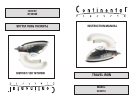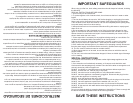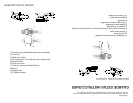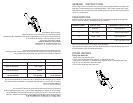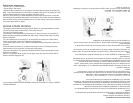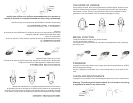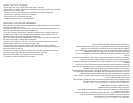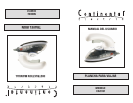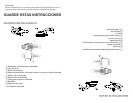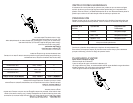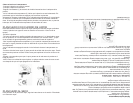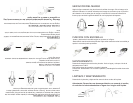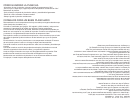HOW TO PUT IT AWAY
- At the end of the using, regulate the steam dial to “Min”point.
- When there is no steam, regulate the temperature dial to “Min” point. Disconnect the
plug of the iron from the socket.
- Empty the reservoir by turning the iron upside down and gently shaking it.
- Leave the iron vertically to cool down completely.
- Roll up the power cord with the re-winder
- Always put the iron away in a vertical position.
ADVICE FOR GOOD IRONING
We recommend using the lowest temperatures with fabrics that have unusual nishes
(sequins, embroidery, ush, etc.).
If the fabric is mixed (e.g. 40% cotton 60% synthetics), set the thermostat to the tem-
perature of the bre requiring the lower temperature.
If you don’t know the composition of the fabric, determine the suitable temperature
by testing on a hidden corner of the garment. Start with a low temperature and in-
crease it gradually until it reaches the ideal temperature.
Never iron areas with traces of perspiration or other marks: the heat of the plate xes
the stains on the fabric, making them irremovable.
The size is more effective if you use a dry iron at a moderate temperature: excess
heat scorches it with the risk of forming a yellow mark.
To avoid marking silk, woolen or synthetic garments shiny, iron them inside out.
To avoid marking velvet garments shiny, iron in one direction (following the bre) and
do not press down on the iron.
The heavier the washing machine is loaded, the more garments come out creased.
This also happens when the spin drying revolutions are very high.
Many fabrics are easier to iron if they are not completely dry.
For example, silk should always be ironed damp.
CÓMO GUARDAR LA PLANCHA
-Al terminar de usar la plancha, coloque la perilla de temperatura en “Min”.
-Una vez que no haya vapor, regule la perilla de temperatura colocándola en “Min”.
Desenchufe la plancha.
-Vacíe el tanque colocando la plancha de cabeza y sacudiéndola ligeramente.
-Enrolle el cordón utilizando el sistema retráctil.
-Siempre guarde la plancha verticalmente.
CONSEJOS PARA UN BUEN PLANCHADO
Recomendamos usar la temperatura más baja con telas que tengan acabados espe-
ciales (lentejuelas, bordados, etc.).
Si la tela es combinada (por ejemplo, 40% algodón y 60% sintética), coloque el ter-
mostato en la temperatura de la bra que requiera la menor temperatura.
Si no se conoce la composición de la tela, determine la temperatura apropiada pro-
bando con una esquina no muy visible de la prenda. Comience con temperatura baja
y aumente el nivel gradualmente hasta alcanzar la temperatura ideal.
Nunca planche zonas con residuos de transpiración u otras manchas ya que el calor
de la base de plancha ja las manchas en la tela haciendo que ya no se puedan
remover.
Es más efectivo si se usa la plancha seca a una temperatura moderada. El exceso
de calor puede quemar la tela con el riesgo de dejar manchas amarillas.
Para evitar manchar con brillo las prendas de seda, lana o sintéticas, plánchelas por
el revés.
Para evitar manchar con brillo las prendas de terciopelo, plánchelas en una sola
dirección (siguiendo la dirección de la bra) y no presione la plancha.
A más se cargue la lavadora con ropa, más arrugadas saldrán las prendas. Esto
también sucede cuando las revoluciones del centrifugado son muy altas.
Muchas telas son más fáciles de planchar si no se encuentran totalmente secas.
Por ejemplo, la seda siempre debe plancharse húmeda.



